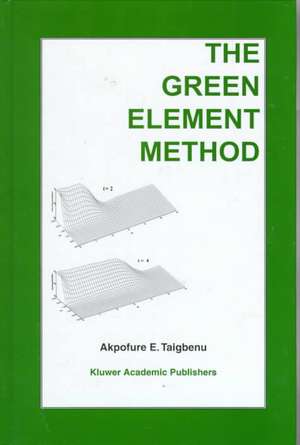The Green Element Method
Autor Akpofure E. Taigbenuen Limba Engleză Hardback – 30 mai 1999
| Toate formatele și edițiile | Preț | Express |
|---|---|---|
| Paperback (1) | 948.16 lei 6-8 săpt. | |
| Springer Us – 2 dec 2010 | 948.16 lei 6-8 săpt. | |
| Hardback (1) | 954.45 lei 6-8 săpt. | |
| Springer Us – 30 mai 1999 | 954.45 lei 6-8 săpt. |
Preț: 954.45 lei
Preț vechi: 1163.97 lei
-18% Nou
Puncte Express: 1432
Preț estimativ în valută:
182.65€ • 189.61$ • 152.30£
182.65€ • 189.61$ • 152.30£
Carte tipărită la comandă
Livrare economică 25 martie-08 aprilie
Preluare comenzi: 021 569.72.76
Specificații
ISBN-13: 9780792385103
ISBN-10: 0792385101
Pagini: 354
Ilustrații: XVI, 354 p.
Dimensiuni: 155 x 235 x 22 mm
Greutate: 0.7 kg
Ediția:1999
Editura: Springer Us
Colecția Springer
Locul publicării:New York, NY, United States
ISBN-10: 0792385101
Pagini: 354
Ilustrații: XVI, 354 p.
Dimensiuni: 155 x 235 x 22 mm
Greutate: 0.7 kg
Ediția:1999
Editura: Springer Us
Colecția Springer
Locul publicării:New York, NY, United States
Public țintă
ResearchDescriere
Most texts on computational methods are borne out of research activities at postgraduate study programs, and this is no exception. After being introduced to the boundary element method (BEM) (then referred to as the boundary integral equation method (BIEM)) in 1981 by Prof. Jim Liggett of Cornell University, a number of graduate students and myself under his supervision took active interest in the development of the theory and its application to a wide range of engineering problems. We certainly achieved some amount of success. A personal desire to have a deeper understanding and appreciation of computational methods prompted one to take related courses in fmite deference method, and to undertake a self-instructed study of variational and fmite element methods. These exposures were not only quite instructive but fruitful, and may have provided the motivation for the current research on the Green element method (GEM) - a name coined by Prof. Liggett in 1987 during my visit as Professor to the School of Civil & Environmental Engineering, Cornell University. The main objectives of this text are to serve as an instructional material to senior undergraduate and first year graduate students undertaking a course in computational methods, and as a resource material for research scientists, applied mathematicians, numerical analysts, and engineers who may wish to take these ideas to other frontiers and applications.
Cuprins
Preface. Acknowledgements. 1: Preliminaries. 2: Linear Laplace/Poisson Equations. 3: Nonlinear Laplace/Poisson Equation. 4: Helmholtz Equation. 5: Transient Diffusion. 6: Transport Equation. 7: Burgers Equation. 8: Unsaturated Flow (Richards Equation). 9: Higher-Order Elements. 10: Steady Two-Dimensional Problems. 11: Unsteady Two-Dimensional Problems. 12: Further Considerations. Appendix A:1. Capabilities of the Program GEMLN1D. A:2. User Manual of the Executable Program GEMLN1D. A:3. Hint to Solutions to Some of the Exercises. Appendix B:1. Element Matrices for Linear Rectangular Elements. B:2. Element Matrices for Linear Triangular Elements. Appendix C:1. Element Matrices for Quadratic Rectangular Elements. C:2. Element Matrices for Quadratic Triangular Elements. Author Index. Subject Index.












